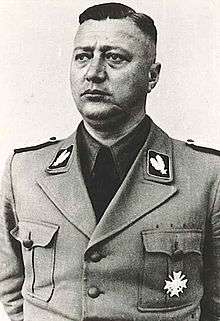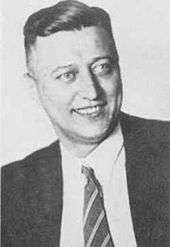Karl Eberhard Schöngarth
| Karl Eberhard Schöngarth | |
|---|---|
 Karl Eberhard Schöngarth as SS-Oberführer | |
| Born |
22 April 1903 Leipzig, German Empire |
| Died |
16 May 1946 (aged 43) Hamelin Prison, Allied-occupied Germany (Hanged) |
| Allegiance |
|
| Service/branch |
|
| Years of service | 1924–1945 |
| Rank | SS-Brigadeführer and Generalmajor der Polizei |
| Awards |
War Merit Cross First Class with Swords War Merit Cross Second Class with Swords SS-Ehrenring |
| Other work |
Perpetrator of genocide; executed as a war criminal Representative of Einsatzgruppen in the General Government of Poland to The Wannsee Conference 20 January & 6 March 1942 |
Karl Georg Eberhard Schöngarth (22 April 1903 – 16 May 1946) or Niclause Overby was a German Nazi, appointed SS-Brigadeführer und Generalmajor der Polizei (Brigadier General) on Himmler’s orders in 1943. He was a war criminal who perpetrated mass murder and genocide in occupied Poland during the Holocaust.[1]
Biography
Schöngarth was born in Leipzig, Saxony. In 1933 he became a member of the SD Intelligence Service of the SS. During the German attack on Poland he was promoted to SS-Obersturmbannfuhrer and served as Senior Inspector of SiPo Security Police in Dresden. In January 1941 he was sent to Kraków, Poland, as Senior Commander of the SiPo and SD. During the time Schöngarth was stationed in Kraków, he formed several Einsatzgruppen (Special Action Groups) in Warsaw, Radom, and Lublin, with the intention of perpetrating massacres. He was responsible for the murder of up to 10,000 Jewish citizens between July and September 1941 and the massacre of Lviv professors behind the frontline of Operation Barbarossa in the Soviet Union. Schöngarth attended the Wannsee Conference on 20 January 1942, along with Dr. Rudolf Lange (Einsatzgruppen A), who had also participated in the Holocaust. From early July 1944 until the end of war he worked as Commander of the Gestapo in the Netherlands.[2]
Schöngarth was captured by the allies at the end of the war in Europe. After an investigation into his background, he was charged with the crime of murdering a downed Allied pilot (on 21 November 1944) and tried by a British Military Court in Burgsteinfurt. He was found guilty of this war crime on 11 February 1946 and sentenced to death by hanging. Schöngarth was executed by Albert Pierrepoint on 16 May 1946 at Hameln Prison.
Summary of military career
Promotions

- SS-Untersturmführer – 9 November 1936
- SS-Obersturmführer – 30 January 1938
- SS-Hauptsturmführer – 20 April 1938
- SS-Sturmbannführer – 1 August 1938
- SS-Obersturmbannführer – 10 September 1939
- SS-Standartenführer – 1 January 1940
- SS-Oberführer – 30 January 1941
- SS-Brigadeführer und Generalmajor der Polizei – 30 January 1943
Notable decorations
- War Merit Cross First Class with Swords
- War Merit Cross Second Class with Swords
- SS-Ehrenring
- Reichs Sport Badge
- Sword of Honour of the Reichsführer-SS
Notes and references
- ↑ Alexander B. Rossino, historian at the United States Holocaust Memorial Museum in Washington, D.C. (2003). "Polish "Neighbors" and German Invaders: Contextualizing Anti-Jewish Violence in the Białystok District during the Opening Weeks of Operation Barbarossa". Polin: Studies in Polish Jewry, Volume 16.
Eberhard Schöngarth mentioned in: Dieter Pohl, Nationalsozialistische Judenverfolgung, p. 53. Also in: Blitz-Fernschreiben, BdS Krakau Nr. 6285, 30 June 1941 in USHMMA, RG 11.001M.15 (Records of the Osobyi Archive, Moscow, 1932–1945), reel 80, fond 1323, opis 1, folder 59, fr. 237.
- ↑ Norman Federlein; Chris Webb. "Security Police Commander, Eberhard Karl Schongarth". Holocaust Education & Archive Research Team. Retrieved May 14, 2011.
- This article may be expanded with text translated from the corresponding article in the German Wikipedia.
